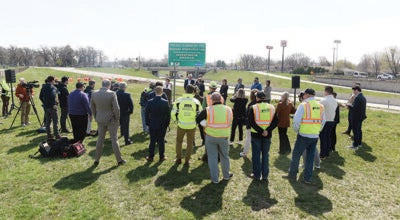Guard calls for soldier support
Published 11:45 am Thursday, April 1, 2010
Shoveling a driveway. Babysitting. Giving financial assistance. Offering a kind word.
Though these acts may seem small by themselves, together they can make a big impact on soldiers and their families.
That was the message Wednesday during a working breakfast for area employers, city and county officials, school leaders, law enforcement and others that encouraged the community to support its military families and ultimately become a Yellow Ribbon Community.
At the event — at the Albert Lea National Guard Armory — local and state leaders with the Minnesota National Guard shared personal stories of the effects of deployment on their families and how the community can strengthen soldiers and their families before, during and after deployment.
Lt. Col. Barbara O’Reilly, chief of deployment-cycle support for the Minnesota National Guard, challenged those in attendance to find a leader in the Albert Lea community who could spearhead and sustain the efforts necessary to become a Yellow Ribbon City.
A Yellow Ribbon City is one that has developed a sustainable action plan for supporting military families throughout the deployment cycle. The plan is ultimately submitted to a Beyond the Yellow Ribbon committee and then given to Gov. Tim Pawlenty for approval.
Farmington is the first city in Minnesota to receive the distinction of becoming a Yellow Ribbon City. Other cities with the distinction are Hugo, Stillwater and Woodbury. Many others are considering it, including Owatonna, which recently had its kickoff event to do so as well.
Beyond the Yellow Ribbon gives help to everyone who serves in the military, not just the National Guard.
“We want to make sure that everyone who comes home is supported,” O’Reilly said.
Albert Lea Superintendent Mike Funk, lieutenant colonel and commander of the 2nd Battalion 135th Infantry Regiment, spoke of a family’s perspective on the 2007 deployment to Kosovo and why it is important to have community support.
He explained he is married with three children, and while he was deployed he got to communicate with his family daily by phone and Internet.
He watched his youngest daughter walk for the first time over the Internet and was included on Christmas and birthdays through the technology as well.
One day, Funk said, he was talking to his wife over the Internet when his youngest child tripped, fell and busted her lip open on the fireplace. Within just a few seconds, his wife and daughter had to leave the house and go to the emergency room.
He said he felt helpless at that moment because there was nothing he could do being several thousand miles away.
While there is a strong need for support for the families of the deployed, there is also a need of support for the soldier who is deployed as well, he said. When there is community support, soldiers are able to better focus on their tasks and feel confident that their families are being taken care of.
There are 13,500 soldiers in the Minnesota National Guard from 63 communities in the state.
Minnesota is No. 1 in the percentage of soldiers it has.
The Minnesota National Guard has an annual budget of $385 million. Of that amount, $375 million comes from the federal government and $10 million comes from the state.
Since 9/11, National Guardsmen from around the country have gone overseas to 33 different countries.
— Information from Brig. Gen. Joe Kelly, director of joint staff of the Minnesota National Guard
“Community support is a full force multiplier for soldiers who are deployed,” Funk said.
Brig. Gen. Joe Kelly, director of joint staff of the Minnesota National Guard, said a community that is involved with Beyond the Yellow Ribbon is going to do more than just have a welcome home parade when their soldiers come back from a deployment. They’re going to take care of their soldiers and their families at any time in the deployment cycle and even long after they come home.
“Whatever you can do, someone’s probably going to need it,” Kelly said.
The Beyond the Yellow Ribbon campaign can be found online at www.beyondtheyellowribbon.org. The site explains what a city needs to do to become a Yellow Ribbon City.
Each Yellow Ribbon City has a sign mounted below the city’s population sign designating it as such.





